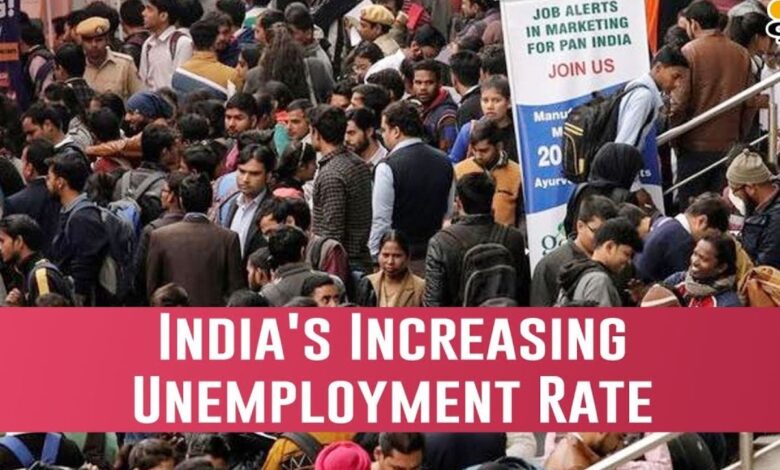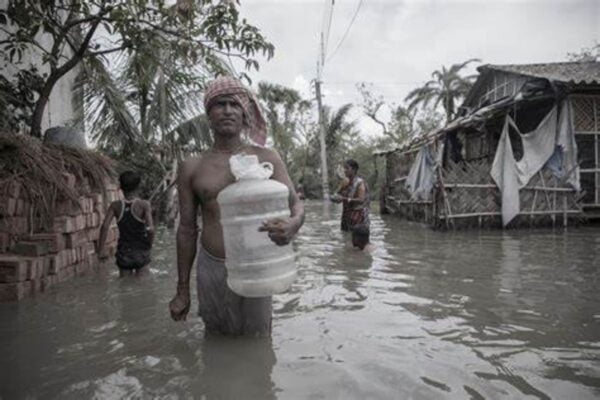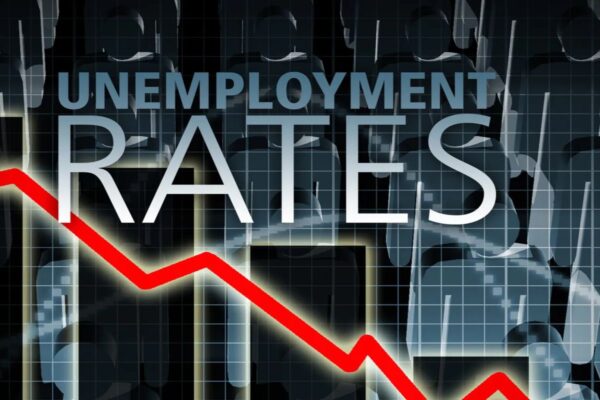India’s Unemployment crisis is an Invisible Pandemic

India’s unemployment crisis is an Invisible pandemic.
Shalini Ghosh is the owner of a reasonably well-known chain of boutiques that sells gifts and ethnic clothing from West Bengal. She has five locations throughout Kolkata and was working on expanding both within the State and outside of it. We will discuss India’s Unemployment in this article.
After that, the pandemic spread, forcing her to close three stores rather than growing. And now that the pandemic has subsided, she is left with a big stockpile of unsold merchandise. Throughout the difficult time, she had been paying all the weavers, artisans, and tailors in her chain, and her money was getting low.
Shalini went on social media to employ a few executives to aggressively sell products from her two surviving locations after opting to clear the unsold stock to offset the financial burn.
She received a deluge of resumes very quickly, and what surprised her the most was the sizeable percentage of them that came from applicants with post-graduate degrees or even more advanced credentials.
With at least two post-graduate degrees, Anand Sekhar* lost his employment in Delhi due to the pandemic. He went back to West Bengal but had trouble getting work there. His maternal uncle’s tiny straw production business in Ultadanga, north of Kolkata, eventually attracted him to work there.

Both Abhijit and Neelima* hold degrees in two different subjects. Neelima was employed by a power sector company with its headquarters in Hyderabad, whereas Abhijit formerly worked for a new media company.
Both of them struggled for months after losing their jobs almost simultaneously and moved to a village outside of Shantiniketan, where the husband transports people in a Toto e-rickshaw and the wife is trying to make a go of turning their mud cottage into an eco-homestay.
Nationwide Occurrence
These are only a handful of the tens of thousands of similar tales that one hears from all around the nation. It might be seen as people redefining themselves and learning skills for new careers. The alternative, more rational and worrying, the theory is that India is on the verge of a critical level of educated unemployment. The severity of the issue is made clear by a look at the disaggregated unemployment data.
Graduate unemployment was 17.8%% in 2022, up from roughly 11% in 2017, according to a Centre for Monitoring Indian Economy (CMIE) analysis that examined data between January and April of that year.
More than one-third of the graduates in some States, including Rajasthan, Bihar, and Andhra Pradesh, have been unable to find employment.
The number of unemployed graduates was 19.3% in 2021; the epidemic seemed to have made matters worse (compared to 14.9 per cent in 2019 and 15.1 per cent in 2020). This increase may be explained by the disturbance to economic activity at this time as many workers made the move back to their hometowns.

According to CMIE figures, Bihar is one State that has seen a high degree of graduate unemployment, with 34.2% of its graduate workforce unemployed. In 2020, Bihar also had the second-highest number of migrant workers who were returning, which would have made things more difficult for those looking for jobs.
As of April, the unemployment rate for graduates was less than 10% in states like Gujarat, Karnataka, and Odisha, among others. In Karnataka, the only State that has managed to keep graduate unemployment below 11% since 2016, it was only 6.1%.
More opportunities for those with higher education are available in states with robust industrial clusters or states with more information technology (IT) and IT-enabled services businesses. For instance, States like Maharashtra and Tamil Nadu had lower jobless rates among graduates, at 9.4% and 10.6%, respectively.
The Second Quarter Results for 2021 from the All-India Quarterly Establishment-based Employment Survey were issued in January by the Union Labour and Employment Ministry (AQEES).
According to the data, there were 3.1 crore people employed overall in nine selected sectors for the quarter ending September 2021, 2 lakh more than for the quarter ending June 2021.
Labor Minister Bhupender Yadav released the report, which covered the industries of manufacturing, construction, trade, transportation, education, health, lodging and dining, IT/BPOs, and financial services. On social media, he expressed his happiness that “employment is showing an increasing trend.”
The Minister may not be content for long, though. According to CMIE data, the unemployment rate increased to 7.80% in June 2022 from 7.12% in May 2022.
Only 390 million jobs were available in June 2022, down from 404 million in May 2022, which resulted in the unemployment of nearly 14 million individuals.
The spotty southwest monsoon in the first fortnight of June, which resulted in decreased demand for and involvement in the labour force, was the main cause of rural India’s severe damage. The overall unemployment rate increased from 9.3 per cent to 12.6% in the quarter that ended in June 2021–2022 as well.
In the previous 12 months, the unemployment rate crossed the June level four times: in August 2021 (8.32%), December 2021 (7.91%), April 2022 (7.83%), and February 2022 (8.11%).
However, it is noteworthy, as noted by CMIE, that one of the biggest drops occurred in June 2022 following the lockdown.
However, the employment market is booming, as evidenced by the JobSpeak Index of online hiring platform Naukri.com. The Index is a study that analyses hiring patterns month over a month using recruiter activity on its website.
The peak in February of this year, when it crossed 3000, was the Index’s closest competitor at 2878 in June 2020. It demonstrates that recruiting activity has been increasing gradually from the beginning of the year, with a nearly 22% annual growth in June 2022 compared to June 2021.
Where the jobs in India are?

However, as indicated by the JobSpeak Index of online hiring site Naukri.com, the job market is thriving. The Index is a study that uses recruiter activity on its website to examine hiring trends month over month.
The Index’s nearest rival at 2878 in June 2020 was the peak in February of this year when it topped 3000. With a nearly 22% yearly growth in June 2022 compared to June 2021, it shows that recruiting activity has been rising progressively from the start of the year.
Similar sentiments were expressed by R.P. Yadav, Chairman and Managing Director of staffing firm Genius Consultants. He said: “The second wave caught us off guard and halted progress after a sharp fall in the wake of the epidemic when the economy was recovering.
It has since appeared considerably better. Pre-pandemic circumstances are starting to emerge as businesses are getting back on track and markets are performing better. Offices and manufacturing facilities are operating at full capacity, and consumer attitudes and purchasing habits have improved.
These figures do not, however, give the whole story. India has almost 1.4 billion inhabitants, with around two-thirds of them being between the ages of 15 and 64. The labour force participation rate in India is 47.1%, according to Jawhar Sircar, a former civil servant who worked in several industrial and labour-related departments at the Center and in West Bengal.
This indicates that 47% of people between the ages of 15 and 60 are employed. This ratio is 57% in Bangladesh, 80% in Nepal, 65-75% on average in Europe, and 67% in the US. It is 57% in Bangladesh, 80% in Nepal, and 65% in Europe. The average across the world is 65%. There are not enough jobs in India.
Every time government entities announce plans to hire, the depth of the misery is on full display. In Himachal Pradesh, 18,000 applicants applied for 42 government jobs as cooks, gardeners, and peons last year, with a sizable proportion of them purportedly post-graduate and doctorate students.
As protesters protesting widespread unemployment stopped roads and railroad tracks in Bihar and Uttar Pradesh in January of this year, a recruitment drive for the railway industry descended into violence. More than 12 million applicants submitted applications for 35,000 clerical positions with the Indian Railways, which is still the country’s largest employer.
In a recent article in Ananda Bazar Patrika, Kaushik Basu, a professor at Cornell University and a former chief economist for the World Bank, stated: “In India, youth unemployment is 25%, which means one out of every four young job seekers is unemployed.
Except for a few Central Asian nations that have experienced one form of a catastrophe or another, it is unlikely that you would find such high and worrying rates of unemployment in other nations. All of the nations that India seeks to contrast itself with have a youth unemployment rate under 15%.
What does India need to do?

India needs to create at least 90 million jobs by 2030, according to a study by the international management consulting firm McKinsey & Co. By that time, a new generation will have reached working age, and millions of people will have moved from agricultural work to better-paying jobs in other sectors, and more women will be participating in the labour force.
A McKinsey report stated that the country must achieve a GDP growth of 8–8.5% on average every year from 2023 to 2030, which sounds a bit ambitious given the economic slowdown and the extreme uncertainties posed by the pandemic.
To generate jobs for so many people, the nation must increase its annual gross domestic product (GDP) growth.
According to some estimates, there may be 40–45 million unemployed people in the nation right now. However, even these figures do not accurately reflect the full extent of unemployment since they do not take into account the significant number of persons who are engaged in disguised unemployment, or working below their capabilities.
This is particularly true when taking into account India’s economic growth level and the absence of social security benefits, which implies that only a small number of individuals can afford to remain unemployed.
It’s interesting to note that the official definition of “unemployed” includes those who are of working age, are looking for work, and are unable to find employment. But does everyone who reaches working age look for employment? For instance, societal constraints that are in place and a lack of social protection have prevented more women from joining the labour field than is practicable.
According to ILO data, India’s female labour force participation rate in 2021 was lower than the world average at 25.1%. For Bangladesh, the similar figure was close to 53%. In addition, men are just as deterred from looking for work when the outlook is poor.
According to CMIE data, India’s overall labour force participation rate was roughly 40%, down from the already low 46% in 2016. It was 47.1% among people in the 15–24 age range.
As a result, the true number of persons who are unable to work to their full ability is not represented in the unemployment figures. This predicament has only worsened as a result of the pandemic.
Many economists have argued that India should prioritise knowledge-intensive industries like communication and broadcasting, financial services, education, health care, IT, business process management, and other professional services over labour-intensive industries like trade, transportation and storage, hotels, and restaurants to increase employment.
To deliver, these sectors will need to work together to maintain and build on the previous good momentum.
They said that the agriculture industry, which is currently carrying more employment than it can support, would have to increasingly concentrate on raising productivity, which will result in job losses. According to CMIE statistics, the percentage of employment in agriculture increased from 38.4% in 2020 to 39.4% in 2021.
Agriculture’s excess labour can be transferred to industries with higher productivity, particularly industries related to agriculture like food processing. By 2030, it is predicted that up to 30 million farm employment could be lost to other industries.
Burgeoning workforce
As was already mentioned, according to McKinsey, a GDP growth rate of 8–8.5% annually will be necessary from 2023 to 2030 to create 90 million net new jobs. Based on current demographics, 60 million additional workers are anticipated to enter the workforce, while 30 million workers are anticipated to transition from farm work to non-farm industries by 2030.
The requested number of 90 million non-farm jobs by 2030 equates to an increase in net employment of 1.5% annually from 2023 to 2030.
This will be consistent with the country’s rise in employment between 2000 and 2012. (it reached an all-time high of 50.8 per cent in the fourth quarter of 2012)
A total of 4 million non-farm jobs were added every year between 2012 and 2018. To accommodate the surge, this number needs triple beginning in 2023, or 12 million non-farm jobs annually.
The need for job creation will only grow if an additional 55 million women join the workforce, an optimistic prediction that might partially address the historical underrepresentation.
In general, there are two factors at play in this situation: the first is the pandemic’s impact on job losses, and the second is India’s historically high unemployment rate. Employability is a crucial factor to consider.
According to Debashis Bhattacharya, a human resources specialist currently employed with Interra, India’s much-heralded demographic dividend is undermined by the employment crisis among graduates.
With 50% of the population under 25, India is seen as a powerhouse when it comes to the labour force that is accessible, but where is the employability, he questioned?
According to the World Economic Forum, just one in four management professionals, one in five engineers, and one in ten graduates who enter the workforce each year in India are employable.
This enables us to link education directly to India’s high rate of youth unemployment. Schools and colleges are failing to prepare students for both the current and future labour markets.
Even for traditional jobs, students are not sufficiently prepared, let alone for the tech-driven jobs of the future, which will emphasise the need for programming, data science, big data, machine learning, artificial intelligence, web development, etc. skills, according to a 2020 World Economic Forum Report.
Therefore, there are three main groups of unemployed people in India today: those looking for work but not finding it, those who are unable to find work, and those who have lost their jobs but are frequently well educated. Together, these three groups have contributed to the employment crisis’s horrifying expansion.
Prime Minister Narendra Modi promised to create millions of jobs throughout his election campaign. He is now under intense pressure to demonstrate that his government is fulfilling that pledge.
This pressure is what prompted Modi to make two crucial announcements that are essential to his chances of winning a third consecutive term in office: the much-hyped and politically-charged armed forces hiring programme known as Agnipath, and the June announcement that 10 lakh Central government vacancies would be filled in 18 months.
It remains to be seen, however, how successful such rash and hastily conceived projects will be in resolving India’s entrenched unemployment crisis given the threat of runaway inflation (annual inflation rate in June 2022 was 7.1%, well above RBI’s target range of 2-6%) and rampant unemployment stoking discontent.
edited and profread by nikita sharma



